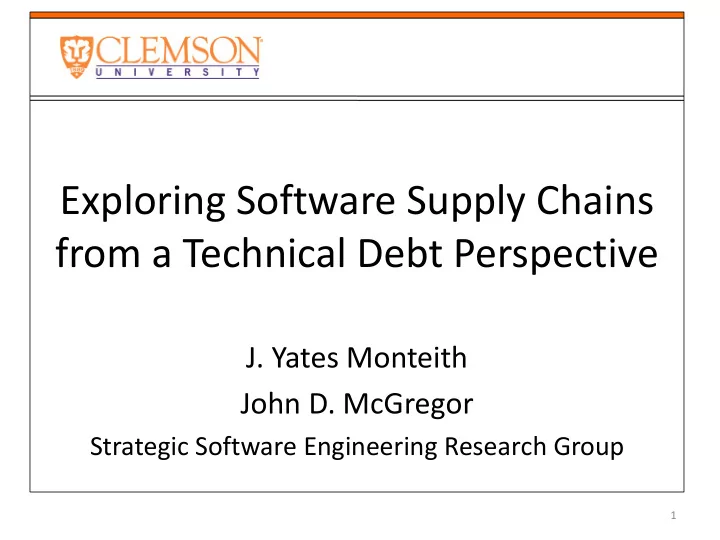

Exploring Software Supply Chains from a Technical Debt Perspective J. Yates Monteith John D. McGregor Strategic Software Engineering Research Group 1
Problem: Quality in the Software Supply Chain • Due diligence requires that deliveries from suppliers be checked for acceptable quality. • Software products are often subjected to acceptance test but these are superficial. • One approach is to establish the reputation of the vendor. • Another is to sample at high value targets. 2
Technical debt • Many sources besides code • We used SONAR in a standard configuration • Need measures for non-code artifacts 3
Betweenness Centrality (BC) • Ratio between the number of shortest paths a node lies in to the total number of shortest paths. – The node on the most shortest paths has the highest betweenness centrality. • Graph theorists use this to identify nodes that are important to graph connectivity and information flow. σ ν ( ) ∑ ν = st BC ( ) σ ≠ ν ≠ s t 4 st
Experiments • Sampled three versions of the Java Development Tools (JDT): 3.4, 3.5 and 3.6. – Maintenance builds. • Experiment 1: Correlation test between technical debt and betweenness centrality. • Experiment 2: Longitudinal Hotspot Evaluation. 5
BC-TD Correlation • Measured betweenness centrality of each file in JDT 3.4, 3.5 and 3.6 using Cytoscape. • Measured technical debt using Sonar Technical Debt plugin. • Performed Pearson Correlation Coefficient test. Version Correlation Coefficient One-tailed P Value 3.4 0.42765676 < 0.0001 3.5 0.42565911 < 0.0001 3.6 0.43607052 < 0.0001 6
Analysis • Results were moderate, but significant correlation. • There exists a positive relationship between technical debt and betweenness centrality. • As one grows, the other grows, though not at the same rate. 7
Longitudinal Evaluation • Utilized same three maintenance versions of JDT: 3.4, 3.5 and 3.6. • Generated dependency graphs for code structures using Cytoscape. • Measured betweenness centrality. – i.e. Nodes that depended or were dependent on the four principle files. 8
Longitudinal Evaluation • Isolated four principle files via high technical debt: ClassFile , Parser , CodeStream and CompletionEngine . • Reduced graph to four principle nodes and first neighbor nodes • Performed the Force-Directed Spring- Embedded layout with weighting on betweenness centrality. – Nodes act as repulsive elements (think electrons). – Edge length determine by betweenness centrality. 9
Eclipse – JDT 3.4 10
Eclipse – JDT 3.5 11
Eclipse – JDT 3.6 12
Coding standard violations 13
Analysis • Examination of node clusters showed cluster 7 was an outlier: excessive technical debt, minor violations, non-minor violations and code size. – However, not the largest cluster in terms of lines of code. • Analysis across versions showed significant refactoring of code, resulting in significantly reduced lines of code, violations and technical debt. • Our technique consistently identified places where the professional staff spent time modifying design and code. 14
Conclusion • Betweenness centrality has a positive relationship with technical debt. • Using whichever of the two is easiest to compute we can identify regions of code that need renovation. • We can also identify the vendors in an ecosystem that are best to use from a technical debt perspective. 15
Recommend
More recommend